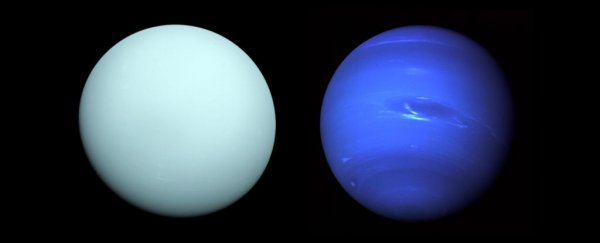Uranus and Neptune are the most twin-like of all the planets in the Solar System. They are almost the same size and mass, have similar compositions and structures, even similar rotation rates.
Which makes one glaring difference quite perplexing. Neptune is a fetching shade of azure, with visible swirling storms. Uranus is more of a featureless, delicate pale teal. If the two planets are so similar, whence the difference in their methane-based blues?
New research, uploaded to preprint server arXiv and awaiting peer review, claims to have found an answer. According to a team led by planetary physicist Patrick Irwin of the University of Oxford in the UK, an extended layer of haze dilutes the hue of Uranus, resulting in a paler orb compared to its more distant twin; fraternal, not identical.
Uranus and Neptune, according to our measurements of the two planets, are structured very similarly. A small, rocky core is surrounded by a mantle of water, ammonia, and methane ices; next, a gaseous atmosphere consisting primarily of hydrogen, helium and methane; and finally the upper atmosphere, including cloud tops. But that atmosphere isn't homogeneous; rather, it is thought to be layered, like every other atmosphere in the Solar System.
Irwin and colleagues analyzed visible and near-infrared observations of the two planets to generate new models of the atmospheric layers. They managed to find models that replicate the observations very well, including the storms on Neptune and the paler shade of Uranus.
In their models, both planets have a layer of photochemical haze. This occurs when ultraviolet radiation from the Sun breaks down aerosol particles in the atmosphere, producing haze particles. It's a common process, seen on Venus, Earth, Saturn, Jupiter, dwarf planet Pluto, and moons Titan and Triton.
The researchers called this the Aerosol-2 layer, and on both planets it seems to be a source of the cloud seeds that condense into methane ice at the lower boundary and snows deeper into the atmosphere. And on Uranus, this layer seems to be twice as opaque as it is on Neptune – and this is why the two planets look different.
"Since these particles are found to be UV-absorbing, this explains Uranus's lower observed UV reflectivity and also explains why Uranus appears to have a paler blue color to the human eye than Neptune, since these particles are found to have a roughly white visible reflectivity spectrum," the researchers wrote in their paper.
"The lower opacity of Neptune's Aerosol-2 layer also explains why dark spots … are easier to observe in Neptune's atmosphere than in Uranus's."
Below the Aerosol-2 layer is a deeper haze layer called Aerosol-1, where the methane re-evaporates and redeposits the haze particles. These haze particles then condense into sub-micron crystals of hydrogen sulfide (that's the smelly compound). The spectral signature of this region is consistent with ice and dark haze.
This Aerosol-1 region, the team believes, is where dark features such as spots and bands observed on Neptune originate. If Neptune's Aerosol-2 layer is thinner, and more transparent, that would make these features more visible.
It's not clear why Neptune's Aerosol-2 layer isn't as dense as Uranus's, but the researchers believe that Neptune's atmosphere might be better at clearing the haze by snowing out methane more efficiently than Uranus.
The findings offer several avenues for further observational studies, the researchers said.
"Future observations of Uranus and Neptune … may help to resolve the question of whether dark spots and dark regions are caused by a darkening or a clearing of the Aerosol-1 layer," they wrote. "This will, we hope, be the focus of future work."
The study has been uploaded to preprint server arXiv.
H/t: New Scientist.
